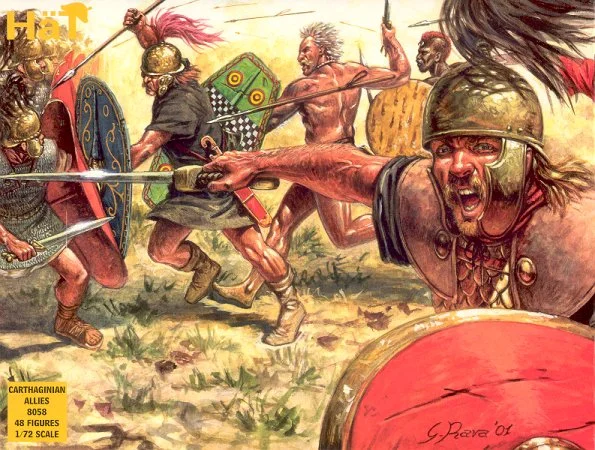- 48 figures
- 8 figure poses
- Molded in dark grey soft plastic
- Assembly, preparation and painting is required
- Box dimensions: 8.0” W x 6.0” H x 1.3” D
- Recommend for hobbyists and miniature gamers 12 years and above.
This set of figures contains some of the more exotic mercenaries who fought for the Carthaginians during the Punic Wars.
In the 4th century Gaul tribes stormed into Italy and thrashed the Roman armies of the time- a hoplite force yet to be formed into the famous Legions. Rome was sacked and from that time until their defeat by Julius Caesar these fierce warriors would pose a constant threat to Roman security. In early times the average Gaul warrior fought fanatically and naked, their hair spiked with white lime wash. By the time Hannibal began recruiting Gauls to his cause only a few warriors continued to fight in this manner. One such group were the elite mercenary Gaisatai. In eastern Galatia (located in modern Turkey) the practice continued with considerable success against the Macedonian successor state of Seleucus.
The Libyan Javelinmen with the unusual hair style represent some of the lighter infantry recruited from Carthaginian subject tribes in North Africa. While Libyans composed the majority of Hannibal's trained heavy infantry it is doubtless that they also contributed other types of mercenaries to the war against Rome. Their distinctive red leather tunics are mentioned by ancient historians as they were also known to serve in Persian and Ptolemaic Egyptian armies.
The Celtiberians were warlike Celtic tribes settled in Spain. As such they showed influences from both cultures; Celtic ferocity and Iberian stubbornness . We have portrayed them with large Celtic style shields and helmets but wearing Spanish cloaks and tunics. These war bands fought in an almost unstoppable wedge formation.
The Lusitani (the figures with the rimmed round shields) were first rate mountain fighters, adept at ambush, raid and skirmish. It should be remembered that Rome continued to fight such Iberian tribes long after the defeat of Carthage. It should also be remembered that Caesar and Pompey first engaged each other on Spanish soil, using Spanish troops as auxiliaries to their legions.

